The phrase “customer focused” gets thrown around a lot.
Many companies don’t even think when they use it. They just do it because “obviously” every company needs to be “customer focused”.
This term is being used so much and so mindlessly that it’s lost all meaning. It’s floating out there with other buzzwords like “best in class” and “results driven”.
What does being “customer focused” even entail anymore?
The definitions of the phrase can vary between different companies. Google doesn’t really help with its millions of results.

Sadly, the real answer is everyone’s favorite word—”depends”.
There is no right or wrong answer. It depends on who your customers are, what your company does, and what your values are. Eventually, you’ll have to create your own definition, specifically for your business.
You might think you already have it figured out. However, if you’re just starting out, it’s a vision more than reality. It’s not a bad thing to think about early on, but don’t get too attached to it.
Figuring out what it means for you is a long process. It requires a lot of time and experience. It also changes over time, as your business and customer base changes, too.
There are still a couple of “universal” things to start doing now to make sure that you’re not just talking the talk. Things that will get you started with being mindfully “customer focused”—and then you can go from there.
The many definitions of “customer focused”
There’s no “official” definition of being “customer focused”. Most companies who put genuine thought into it have made up their own.
There are a few overlapping thoughts in every definition out there, but the weight of each part depends on the company behind it.
Here are two definitions we like and strongly agree with.
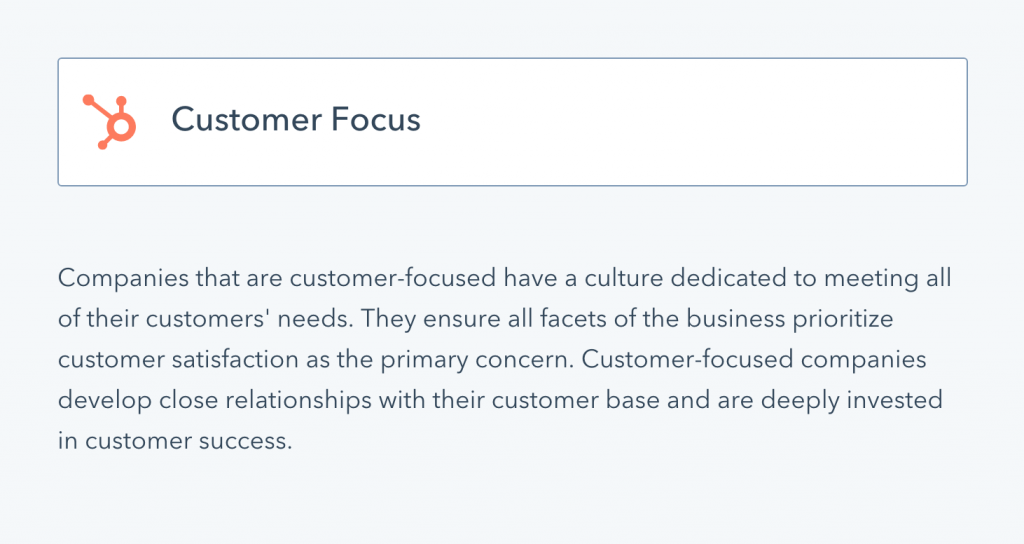
2) Helpscout’s definition (Shep Hyken):
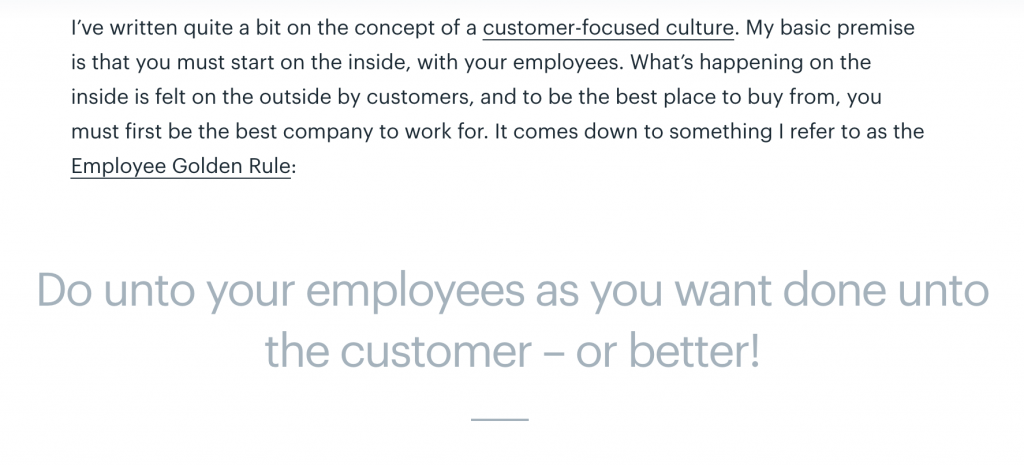
Here are the main takeaways from both definitions:
- “All facets of the business prioritize customer satisfaction as the primary concern.”
- “Develop close relationships with their customer base.”
- “You must start on the inside, with your employees. What’s happening on the inside is felt on the outside by customers.”
Based on these, here are three things to do to start making your company customer focused.
Being customer focused is about building relationships
What’s the first requirement of building any relationship?
It’s getting to know each other.
Your customers shouldn’t be nameless and faceless entities that just exist out there and hand you money. To build a relationship with them, you have to get to know them, one by one.
Really getting to know your customers is easy at the beginning, when you don’t have too many. Every new sign up is exciting. You go and learn about them out of sheer curiosity. It’s also much easier to reach out personally and connect on a deeper level.

When you start getting more customers, keeping this curiosity becomes harder. You don’t have time to go and learn about every new customer individually.
Don’t let that stop you from building relationships and getting to know them.
Here are three tips to do this at any stage.
Ask questions
When your customers come on board, ask them a question. This question aims to give you more insight into what their relationship with you means.
For example, when a customer onboards, we ask them what problem they’re trying to solve with Canny:
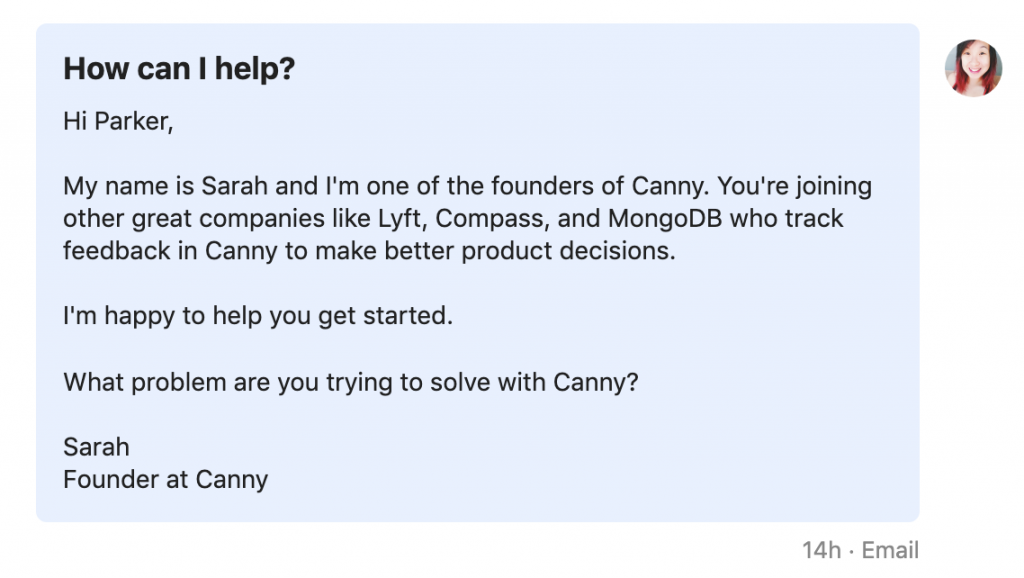
This is an automated email, but the question is genuine, and we reply to everyone who responds. We make the first (easy and automated) step, and if the customer wants to chat more, we’ll happily find time for it.
We’ll also have this extra information for whenever the customer reaches out later. It’s the first step of getting to know our new customer, and it’s fairly low effort.
Store information and use it
Keeping basic information on your customers is always necessary. Try to take a step further and collect any and all extra bits of info in the same place.
Having a section for free-hand notes on each customer allows you to do that. Whether you’re having a live chat, emailing back and forth, or simply doing research, add anything interesting or valuable in there.
For example, we use Intercom, and they have a handy “company notes” section for this:
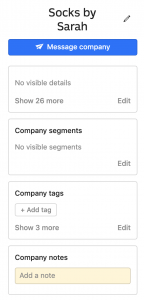
When a customer reaches out for support, look at this info before you respond. This way, you don’t have to ask extra questions, and they don’t have to answer any. You can also use interesting tidbits about them to warm up the conversation.
Knowing the customers’ background and remembering individual information makes them feel important. Well, they are important anyway, but might not feel like it. Give them that warm and fuzzy moment, and they’ll open up much more easily.
Be human
You’re not a robot, and neither are your customers. There’s nothing wrong with showing that. Let your personality shine through when talking to your customers.
If you’re interested in something they do or say, tell them. If they seem to be in a fun mood, crack a joke. Again—it’s all about getting to know them and having a conversation beyond just talking business.
We’ve had many Intercom conversations turn into completely random chats, with topics ranging from surfing to model planes to man flu.
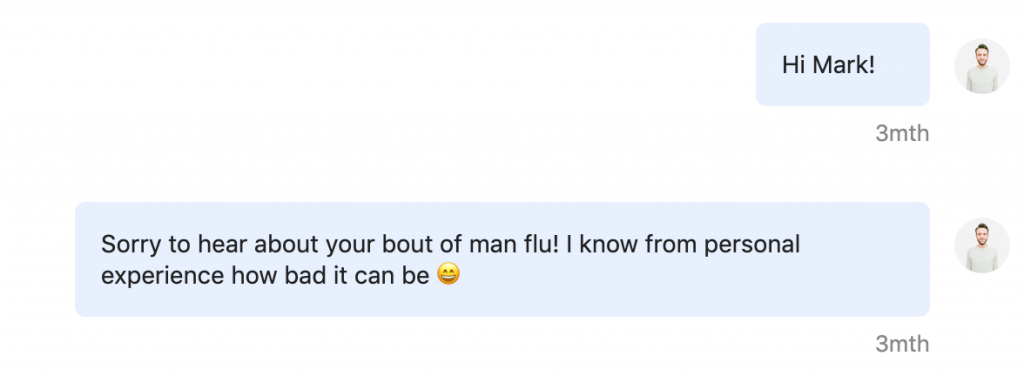
All the above will help you build a relationship with your customers beyond business.
The more personal of a relationship you can build, the more loyal your customers will be. The more loyal your customers are, the easier it will be for you to find out what their real needs are.
Being customer focused means going from the inside out
Like Shep from Help Scout said—before working on your customers, you need to make sure you work on your own team.
It’s hard to fake being customer centric as a part of your core values if it isn’t true. Even if you try, it’ll come off disingenuous.
There’s two main aspects to making sure your customer centric attitude shines from the inside out.
Treating your employees well
If your team is happy, nurtured, and valued, they’ll be emotionally invested in the company. This means they’ll care about what happens to it, rather than just being there to collect a paycheck.
“How to treat your employees well” is a very complex topic, and pretty much requires a post of its own. Here is a good one until we get around to writing one.
The basic idea is that when your team members feel good in your company, they want to stay there.
When they want to stay there, they’ll care about how it’s doing.
When they care about how the company is doing, they put their best foot forward in everything that concerns its public image. This includes customer communication.
This will help with creating those very important customer relationships we mentioned before.
Talking to your team about customers
In small startups, pretty much everyone does support. In bigger ones, there are people who don’t interact with customers at all.
That doesn’t mean they shouldn’t think about it at all.
Being customer focused is a part of your whole team’s culture. Sit down with your team and talk about customers. It doesn’t matter whether it’s in a meeting, a call, or an async document.
Ask:
- What do they think being customer focused means?
- What does good support mean to them?
- What are their best and worst experiences with other companies doing support?
- What do they think are the most important aspects of good support? Speed? Being detailed?
- Do they know who your “average” customer is and what they expect from you?
- How would they want the company to be perceived by customers?
Make notes of all of this. At the end, you should have consolidated “guidelines” on what your whole team thinks about:
- Who your customers are
- How you want to treat them
- Which aspects of customer support and experience are most important
Then, discuss what this means for every part of your company separately:
- How does this change the messaging your marketers send out?
- How does it change how your support people talk to customers?
- How does it change how your product team prioritizes tasks?
If there are things that need to be changed based on your discussions, make them into concrete tasks:
- The product team should regularly revisit and assess customer feedback instead of ignoring it
- Marketers should use more customer-value-centric language in their pitches
- The support team should put extra effort into taking individual customer notes
Have these discussions regularly. Your attitude towards being “customer centric” can and should change over time.
Even if everyone does do support in your company, if you don’t have regular conversations about it, then there’s a good chance you’re not on the same page.
Not being on the same page creates consistency issues in customer communication, and even decision making.
Make sure your whole team is healthy, happy, and excited to help your business succeed. If everyone is on the same page about what that means customers wise, it’ll be much easier to show it to the outside world.
It’s an ongoing process and takes a long time, but it’s better to start sooner rather than later.
Being customer focused means acting on feedback
We should all listen to feedback, of course. But, that’s not enough.
“Listening to feedback” tends to be a similar filler phrase to “being customer focused”.
There’s a big difference between just listening vs actually doing something about it.
“Customer satisfaction” doesn’t just mean customer support and how good or bad it is. It also means how your whole company changes according to what your customers need and want.
Your end goal should always be adding more value to your users.
Adding value:
- Increases customer satisfaction
- Increases your bottom line
It’s a win-win goal to have. You’re not going to know how to add the most value to your customers unless you ask them. The whole process of building your roadmap starts with asking for feedback from your customers.

You might think you know what’s best for them. You don’t.
Your customers are the ones using your product or service on a regular basis, for real life use cases. They are a gold mine when it comes to prioritizing your product roadmap for optimal value.
Stop just saying “I’ll pass it on to the team”—valuable feedback can and will get lost if you don’t have a system.
Get into the habit of logging, organizing, and revisiting the feedback you get.
It’ll be much easier to put together future plans, and your customers can see the things they’ve asked for come to life.
Stand out by actually thinking about being “customer focused”
“Customer focused” is become an overused and non-meaningful term. The fact that many other companies use it carelessly doesn’t mean you have to.
Start with these three basic foundational principles we mentioned above. After you’ve solidified those, you can start thinking about what it really means for your business on a deeper level.
You’ll get much further than businesses that throw the term around, but don’t really mean it.
What does “customer focused” mean to you?







Absolutely true. Not many companies, especially in the B2B space, really understand ‘what is customer focused’ or ‘keeping the user at the center of decision making’ means. It is about knowing customer and user better, and understanding their needs better so that the company can continuously build the right product that can be hired by a similar set of customers. Being customer focused doesn’t mean saying ‘yes’ to customers always. Many times it’s about saying no unique requests to be relevant to a larger set of customers and the company’s long term success.